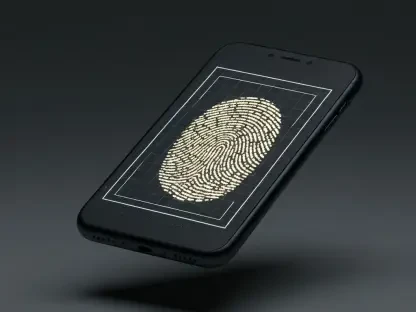In recent years, the intersection of biometric security and artificial intelligence (AI) has become increasingly significant in the mobile technology landscape. Biometric authentication utilizes unique biological traits like fingerprints, facial structures, and iris patterns to validate identities, providing an advanced layer of protection beyond traditional security measures. This technology is widely applied, from unlocking smartphones to protecting sensitive government installations. The appeal lies in its seamless user experience and robust security framework. However, the rapidly evolving technology landscape and diverse application requirements have led to a fragmented ecosystem with limited standardization, posing unique challenges for consistency and reliability.
The Dual Nature of Biometric Data
Biometric data’s allure resides in its uniqueness, offering an unmatched degree of security for identity verification. Unlike passwords or PINs, biometrics can’t be easily forgotten or guessed, positioning biometric authentication as a leading solution for secure mobile access. Nevertheless, this immutable nature also poses significant risks if such data is compromised. Biometric data cannot be changed once lost, thus magnifying the consequences of any breach. The increasingly sophisticated AI technologies now equip cybercriminals to spoof biometrics with alarming precision, using strategies like deepfake videos to bypass facial recognition systems. Such AI-driven advances have broadened attack vectors, making biometric systems more vulnerable to deceptive tactics.
To counter these threats, technology developers and industry leaders are compelled to reconsider the security frameworks underpinning biometric systems. The notion of a biometric system rendered ineffective through AI counteractions not only poses a threat to users’ confidential data but can also erode trust in the technology. The potential for biometric spoofing highlights the need for stringent security measures that include state-of-the-art detection capabilities. By implementing robust defense protocols such as enhanced liveness detection, developers aim to authenticate physiological presence, thereby averting AI-facilitated spoofing incidents. These strategies form a critical line of defense in ensuring the reliability of biometric security systems.
Standardization and Compliance in Biometric Systems
The fragmented nature of biometric ecosystems has prompted efforts toward creating standardized protocols that ensure compliance and security across various applications. Android has spearheaded these initiatives via a classification system for biometric solutions that demands adherence to rigorous security standards. Its Compatibility Definition Documents (CDD) set comprehensive requirements for biometric authentication systems, incorporating metrics such as False Acceptance Rate (FAR), False Rejection Rate (FRR), and Spoof Acceptance Rate (SAR). These standards are subject to validation through independent third-party testing, compelling industry participants to meet high-performance benchmarks.
Integration of international standards like ISO/IEC 30107, focusing on Presentation Attack Detection (PAD), adds another layer of resilience against potential intrusions. These collaborative international efforts encourage robust liveness detection, crucial in distinguishing genuine use from unauthorized AI-generated attempts. For Original Equipment Manufacturers (OEMs) and biometric solution providers, aligning with these standards presents a dual-edged challenge: maintaining cutting-edge innovation while ensuring security protocols are not compromised. Compliance not only safeguards users but also elevates trust in biometric systems, consequently broadening their market acceptance and applications across diverse sectors.
Expanding Applications and the Role of Innovation
The pursuit of balance between security and usability is crucial as biometric authentication continues to evolve. Emerging trends indicate a progressive wave of use cases, extending beyond conventional applications. Retail transactions, access controls, and automotive industries are embracing biometrics for facilitating seamless customer experiences. One particularly promising avenue is the integration of biometrics into electronic identity verification (eID) systems and electronic Know Your Customer (eKYC) processes. These applications can revolutionize digital identity verification by expediting and securing online interactions, streamlining previously cumbersome authenticating procedures.
This dynamic innovation in biometric applications underscores the necessity for inclusive design that considers diverse demographic characteristics and environmental variances. A robust inclusion strategy can significantly enhance system performance by effectively tackling potential discrepancies across user groups. Addressing inherent biases is imperative, as they represent security risks that could lead to exploitation by malicious entities. By consistently refining biometric authentication methods—grounded in fairness and precision—stakeholders can anticipate the development of products that aptly bridge security with user-friendliness, enabling technology to enter uncharted territories.
Future Prospects for Mobile Biometrics
In recent years, the blend of biometric security and artificial intelligence (AI) has gained prominence within the realm of mobile technology. Biometric authentication relies on distinct biological features—such as fingerprints, facial recognition, and iris scans—to verify identities, offering a superior level of security beyond what traditional methods provide. It’s widely used for various purposes, from unlocking personal devices like smartphones to safeguarding critical government facilities. What makes this technology attractive is its intuitive, user-friendly experience coupled with a solid security infrastructure. However, as technology evolves rapidly and is applied in diverse ways, it has created a fragmented landscape with minimal standardization. This lack of uniformity presents unique hurdles for maintaining consistency and reliability in biometric security systems. Therefore, while promising, the marriage of AI and biometrics requires ongoing advances and standardization efforts to reach its full potential and ensure dependable security.









